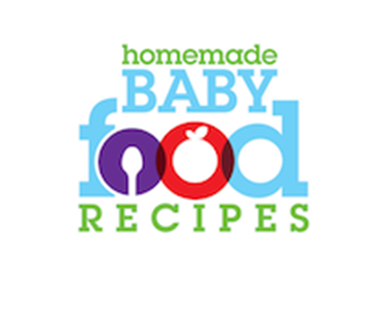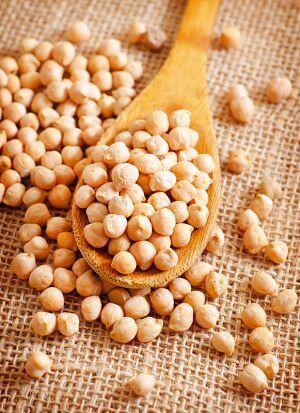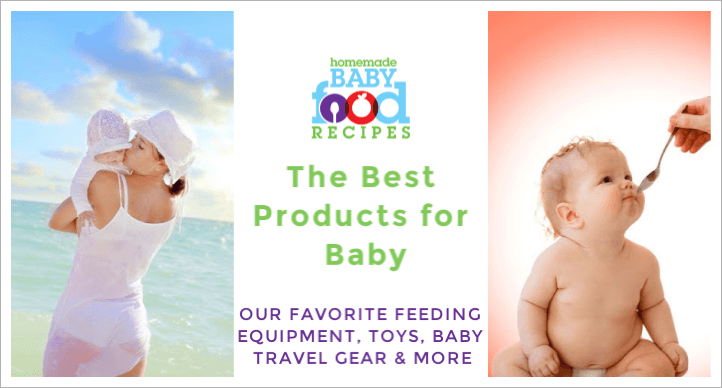Introducing Chickpeas: Creative Baby Food Recipes and Tips
Updated: Sept 22, 2023
Without a doubt, chickpeas (also known as garbanzo beans) are a fab food for baby!
These little legumes have a mild flavour that lends itself perfectly to all sorts of dishes, a wonderful texture that produces velvety smooth purees and they’re a superb source of a wide range of important nutrients.
On this page we’ll show you how and when to introduce chickpeas to your baby and the many creative ways you can incorporate them into his diet.
When can I introduce chickpeas to my baby?
With your doctor’s consent, chickpeas may be introduced to your baby from 6 months of age.
However, many parents choose to wait until around 8 months to give their little ones their first taste of chickpeas.
That’s because chickpeas – like many other legumes – have a tendency to cause uncomfortable gas (or wind) and are not quite as gentle on baby’s developing digestive system as most simple fruits and veggies.
If chickpeas cause gas, shouldn’t I avoid them altogether?
No, although there’s certainly no harm in delaying them until baby is ready!
But some of the healthiest foods around – broccoli, for example – do, unfortunately, cause gas.
Yet they also provide huge nutritional benefits that you really don’t want your baby to miss out on!
The best option, then, is to take steps to minimize or eliminate the problem.
It’s also worth bearing in mind the fact that – in some cultures – these types of food are eaten multiple times per day, by infants and adults alike.
This demonstrates that – over time and with regular consumption – the body learns to process these foods more efficiently and the problems associated with eating them tend to diminish.
How to feed chickpeas to your baby without making him gassy!
Please note that these suggestions should to help prevent gas but they are not guaranteed to do so.
YOU know your baby best – if he seems to have a delicate tummy, then do wait until he’s comfortably digesting a wide range of fruits and vegetables before offering chickpeas.
And introduce them slowly, following the four day rule, so you can easily spot if they are causing any digestive problems.
- Start with dried chickpeas rather than canned.
That’s so you can carry out the steps we’re about to describe.
Canned chickpeas are already cooked and won’t have been through this process. - Soak your dried chickpeas overnight.
Discard the water, then soak them in fresh water for another few hours.
Cook as needed. - If you want to be extra cautious, follow step 2 (above), but cook for only 30 mins.
Then drain the chickpeas, refill the pot with fresh water and continue to cook until done.
It may be tedious, but this repetitive changing of the water is one of the most popular and effective methods for reducing the gassiness caused by legumes!
An optional extra step is to add a big slice of peeled fresh ginger to the pot when you cook the chickpeas.
Ginger is a marvelous aid to digestion.
Follow a meal containing chickpeas with a dessert of natural yogurt – this will help balance the healthy bacteria in baby’s gut.
Remember:
Take things slowly, offering only a small amount of chickpeas at the first sitting, then gradually increasing the amount as your baby becomes accustomed to eating them.
Chickpea allergy
Allergic reactions to chickpeas don’t seem to be particularly common in the west.
But in India, where chickpeas are very widely consumed – the incidence of chickpea allergy is far higher.
Thus, it’s important to check with your doctor before introducing chickpeas to your baby and to follow the four day rule when introducing them.
This will help you easily identify them as the cause of any potential reaction.
It’s also worth noting that your child’s chance of reacting to chickpeas is higher if he is allergic to soy, lentils or latex, or if there is a family history of these allergies.
Types of chickpeas
Chickpeas are known by various names, including garbanzo beans, ceci beans and desi.
They also happen to be one of the earliest cultivated vegetables (those ancient civilizations certainly knew a thing or two about nutrition!).
Desi – widely used in Indian cuisine – are, in fact, a different variety of chickpea to those we’re familiar with in the west.
The type of chickpea we’re more used to seeing is the kabuli variety, which are smooth and creamy in colour.
Desi, on the other hand, are darker in colour, smaller and with a rougher coating than kabuli.
Desi, also known as Bengal gram or kala chana, are actually the most nutritious variety, with a higher concentration of antioxidants in their slightly thicker skins.
You can often find desi at Asian stores or ethnic markets, so they’re worth hunting down and giving a try in your baby food recipes!
But it’s important to remember that their skins are a little thicker, and may not puree as smoothly.
If you can’t get hold of desi chickpeas, however, don’t worry – the kabuli variety found in western stores are highly nutritious too!
Chickpea nutrition facts
Good things come in small packages – and that’s certainly true of these wonderful little legumes!
Chickpeas are packed with protein, making them a highly desirable part of a vegetarian diet. They’re also a rich source of…
The fibre in chickpeas is insoluble, and whilst that may cause a little gas, it’s actually important for healthy colon function and helps prevent against colon cancer in later life.
Chickpeas are a superb source of energy (as if your baby needed any more!) and should be considered a fabulous addition to every little person’s diet!
Chickpeas are good for mommy and daddy too…
They’re very satisfying, and regularly eating chickpeas leaves you less likely to reach for unhealthy snacks during the day.
We love to make these super simple crunchy chickpeas for the adults and older children… try them yourself and you’ll soon prefer them to chips!
- Open a can of chickpeas, drain them and spread them on a baking sheet.
- Dry them with a piece of paper towel, then drizzle with olive oil and sprinkle with salt and/or your favourite spices. Toss to coat.
- Bake for 35 to 40 mins at 350 deg F. They will be golden brown and amazingly crunchy (they may look golden far earlier in the cooking time but they need longer to become crunchy).
- Enjoy!
Buying and storing chickpeas
You may use either canned or dried chickpeas in your baby food recipes. Here’s a brief summary of the pros and cons of each…
CANNED CHICKPEAS
- are convenient – just open, drain, and you’re good to go!
- may contain salt – if so, drain and rinse. As an added precaution, you may remove the skins (they slip right off).
- contain the same amount of nutrients of home-cooked chickpeas with one exception – they only contain half the amount of folate.
DRIED CHICKPEAS
- are cheaper than canned.
- may be soaked using the method described earlier in this article, in order to minimize ‘gassiness’.
- contain twice as much folate as canned chickpeas.
- are salt free.
- need to be cooked for around 2 hours.
Dried chickpeas may be stored in an airtight container for up to 12 months in a cool, dark place.
Cooked chickpeas (or opened canned chickpeas) may be kept for up to 48 hours in the fridge, or up to one month in the freezer.
How to cook dried chickpeas
Time saving tip…
If cooking dried chickpeas seems like too much work, remember you can save time by cooking a huge batch all in one go and then freezing them in portions for future use!
First, pick through the chickpeas and remove any small stones, dirt and debris (quite common in dried legumes).
Next, we recommend following the soaking technique described above.
If you don’t want to go through the entire process, at least do the initial overnight soak – this reduces the cooking time, thereby preserving more of the nutrients in the chickpeas.
Even a 4 hour soak can shave 20 to 30 minutes off the cooking time!
Place your chickpeas (soaked or unsoaked) in a large saucepan.
Completely cover them with plenty of water.
Bring to the boil, then reduce the heat to a simmer.
Cook, partially covered, for around 1 1/2 to 2 hours, skimming off any impurities that may rise to the top of the water.
If the chickpeas were pre-soaked, reduce the time by approximately 20 to 30 minutes for every 4 hours they were soaked.
How to make a chickpea puree for baby
Use cooked chickpeas, either from a can, or cooked from dried (as described above).
If the chickpeas were canned in a salt solution, it’s a good idea to rinse them and remove the skins (in order to remove the salt).
However, the skins do contain quite a lot of nutrients and we find they puree quite well, so we prefer to cook chickpeas ourselves or buy the ‘no salt’ canned varieties.
Simply puree the chickpeas in a blender, adding a little water, milk or broth to achieve the consistency your baby enjoys.
Tip – an easy way to transform the flavour of a simple chickpea puree is to cook the chickpeas in a good, homemade stock instead of water. Try one of these delicious recipes:
Simple baby food ideas with chickpeas
- Serve cooked chickpeas as a finger food, just as they are!
We like to squash them a little bit with the back of a spoon so they’re not so round and won’t present a choking hazard.
We also like to mix them with cooked black beans – the colour contrast is really eye-catching! - Throw cooked chickpeas into all your stews and casseroles.
- Use chickpea puree (which is very mild in taste) as a thickener for other runny purees – it goes well with zucchini for example, which is rather watery by itself.
- Mash cooked chickpeas with cooked egg yolk for a nutritious sandwich spread or toast topper.
- Thin your chickpea puree with apple juice for an interesting, sweet flavour.
- Puree chickpeas with cooked beets for a fun and colourful food that’s packed with goodness.
- Try our yummy hummus recipes for babies.
Chickpea Baby Food Recipes
Chickpea, banana and pumpkin puree
Sounds weird, tastes wonderful – and it’s SO nutritious!
1 tbsp cooked pumpkin (canned is fine)
1 tbsp cooked chickpeas
1/2 small ripe banana
- Puree together for a creamy and delicious treat.
No-cook chickpea and tuna salad
1 tbsp cooked chickpeas
1 tsp canned lite tuna
1 to 2 tsp natural yogurt
little pinch of dried dill weed (optional)
- Puree the chickpeas, then stir in the tuna, dill (if using) and as much yogurt as you need to create the perfect texture for your baby.
Chickpea and chicken salad
1 tbsp cooked chickpeas, mashed
1 tbsp cooked chicken, chopped finely
1/2 avocado, peeled and pitted
little olive oil
- Place the avocado in a blender and add a few drops of olive oil. Puree until smooth.
- Stir in the remaining ingredients. Mash for older babies or return to the blender and puree for those who like their meals smooth!
Chickpea and sweet potato soup
6 oz (3/4 cup) cooked chickpeas
1 lb (2 cups) sweet potato, peeled and diced
1 tbsp olive oil
1 small onion, chopped
1 clove of garlic, crushed (optional)
1 tsp ground cumin
1 tsp ground coriander
3 cups low sodium or homemade chicken or vegetable stock
- Heat the oil in a medium saucepan and cook the onion and garlic (if using) for a few minutes.
- Stir in the cumin and coriander and cook for 2 more minutes.
- Add the diced sweet potato, cook for a further 2 minutes, then pour in the stock.
- Bring to the boil, then reduce the heat.
- Cook, covered, for 15 minutes.
- Remove the lid, add the chickpeas, then re-cover.
- Cook for another 10 minutes, then allow to cool.
- Blend in a food processor until smooth and warm through before serving.
Fruity chickpea puree
Chickpeas are as good in sweet dishes as they are in savoury – our little ones loved this unusual combo!
1 tbsp cooked chickpeas
1/2 pear, cored and diced
3 tbsp apple juice
1 tsp raisins
pinch cinnamon
- Place the pear dice and raisins in a small saucepan and add the apple juice.
- Bring to a boil, then immediately reduce the heat and simmer gently for 2 minutes.
- Add the chickpeas and cook for 3 minutes more. until the pear dice are tender.
- Allow to cool, then transfer to a food processor.
- Add the cinnamon, then puree until smooth, adding a little more apple juice if necessary
Curried chickpeas and apples
1 white potato, diced
1 small sweet potato, diced
1/2 small onion, chopped
1 small red bell pepper, seeded and chopped
4 oz (1/2 cup) frozen peas, thawed
1 apple, cored and chopped
6 oz (3/4 cup) cooked chickpeas
1 tbsp olive oil
1 1/2 tsp curry powder
- Heat the oil in a frying pan.
- Add the white and sweet potato dice, the chopped onion and the curry powder. Toss together.
- Lower the heat to very low, cover, and cook all the ingredients gently until the potatoes are almost tender.
- Uncover and add the bell pepper, peas and chickpeas. Re-cover and cook for 5 mins more.
- Add the diced apple and continue to cook, uncovered, until the apple is very soft, stirring often.
- Mash well or puree in a blender, then serve over brown rice.
Chickpea ‘n coconut curry
16 oz (2 cups) cooked chickpeas
1 can unsweetened coconut milk
1 ripe, medium tomato, chopped
1 medium carrot, diced
2 tsp turmeric
big pinch cinnamon
pinch ground cloves
2 garlic cloves, crushed
- Mix everything together in a saucepan.
- Bring to a boil, then lower the heat and simmer, covered, for 30 mins.
- Mash or puree in a blender, then serve over rice or quinoa.
Note: We cook this for the whole family, adding a little salt for the grown ups. It’s delish!
Chickpeas and other legumes may not be suitable for babies with G6PD Deficiency – please see this page for more information.


